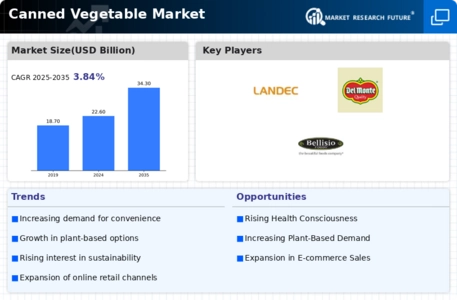Rising Health Consciousness
The Global Canned Vegetable Industry experiences a notable surge in demand due to increasing health consciousness among consumers. As individuals become more aware of the nutritional benefits of vegetables, the preference for canned options, which retain essential vitamins and minerals, grows. This trend is particularly evident in regions where fresh produce is less accessible. For instance, canned vegetables provide a convenient and shelf-stable alternative, appealing to busy lifestyles. The market is projected to reach 22.6 USD Billion in 2024, reflecting a shift towards healthier eating habits. This growing awareness is likely to further drive the market as consumers seek nutritious and convenient food options.
Global Distribution Networks
The expansion of global distribution networks plays a crucial role in the Global Canned Vegetable Industry, facilitating access to a broader consumer base. Improved logistics and supply chain efficiencies enable manufacturers to reach diverse markets, including remote areas where fresh produce may be limited. This accessibility is vital for increasing the consumption of canned vegetables, as it allows consumers in various regions to enjoy the benefits of these products. Furthermore, partnerships with retailers and online platforms enhance visibility and availability, driving sales growth. As distribution channels continue to evolve, the market is expected to thrive, reflecting the importance of strategic logistics in meeting consumer demand.
Diverse Culinary Applications
The versatility of canned vegetables significantly contributes to the growth of the Global Canned Vegetable Industry. These products are not only staples in traditional cuisines but also find applications in modern culinary practices, including fusion dishes and meal kits. The ability to incorporate canned vegetables into a wide array of recipes enhances their appeal to diverse consumer segments. This adaptability is particularly advantageous in regions with multicultural populations, where varied culinary preferences exist. As consumers seek innovative meal solutions, the demand for canned vegetables is likely to rise, further solidifying their position in the market. This trend underscores the importance of product diversity in driving market expansion.
Market Trends and Projections
The Global Canned Vegetable Industry is characterized by various trends and projections that indicate a robust growth trajectory. The market is anticipated to reach 22.6 USD Billion in 2024, with a steady increase expected to 34.3 USD Billion by 2035. This growth is underpinned by a compound annual growth rate (CAGR) of 3.84% from 2025 to 2035. These figures suggest a favorable outlook for the industry, driven by factors such as health consciousness, convenience, and sustainability. The evolving preferences of consumers are likely to shape the market landscape, presenting opportunities for innovation and expansion in the canned vegetable sector.
Convenience and Shelf Stability
Convenience plays a pivotal role in the Global Canned Vegetable Industry, as consumers increasingly favor ready-to-eat and easy-to-prepare food options. Canned vegetables offer significant advantages, including extended shelf life and minimal preparation time, making them an attractive choice for busy households. This trend is particularly pronounced in urban areas, where fast-paced lifestyles dominate. The ability to store canned vegetables for long periods without spoilage aligns with the needs of consumers seeking practicality in their food choices. As a result, the market is expected to grow, with projections indicating a value of 34.3 USD Billion by 2035, driven by the demand for convenient meal solutions.
Sustainability and Eco-Friendly Practices
Sustainability concerns are increasingly influencing the Global Canned Vegetable Industry, as consumers gravitate towards brands that prioritize eco-friendly practices. The emphasis on sustainable sourcing and packaging resonates with environmentally conscious buyers, leading to a preference for canned vegetables that utilize recyclable materials. Companies are responding by adopting greener production methods and transparent supply chains. This shift not only attracts consumers but also aligns with global efforts to reduce food waste and carbon footprints. As sustainability becomes a key purchasing criterion, the market is poised for growth, with a projected CAGR of 3.84% from 2025 to 2035, reflecting the increasing importance of eco-friendly initiatives.



 Source: Secondary Research, Primary Research, Market Research Future Database, and Analyst Review
Source: Secondary Research, Primary Research, Market Research Future Database, and Analyst Review










Leave a Comment